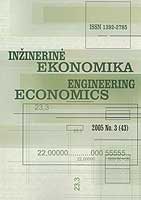The Possibilities for the Application of the Logistic Model of Accumulation
The Possibilities for the Application of the Logistic Model of Accumulation
Author(s): Stasys Girdzijauskas, Vytautas BoguslauskasSubject(s): Economy, Methodology and research technology, Transport / Logistics
Published by: Kauno Technologijos Universitetas
Keywords: population; product; logistic model of accumulation; exhaustible resources; compound interest; future value; lowest square method; regression equation; gross domestic product (GDP);
Summary/Abstract: As a rule, under naturally operating conditions, especially in a closed environment, the product (understood in a general sense) cannot grow at equal rate. It is particularly obvious in a closed system maintaining limited resources necessary for the support of the concrete product’s growth. In such a system, an initial rate of the product’s increase gradually diminishes until its considerable decline and total cessation. Therefore, to model such a system, the differential equation of the growth of the population should be supplied with the factor expressing a straightly decreasing function. Hence the logistic model of accumulation is achieved. Meanwhile, the exponential function remains a special case in the model. Sometimes it is reasonable to equate both the logistic and exponential functions. Then the coefficients of equivalence between the logistic and the exponential growth should be worked out. The article presents a simplified way of the calculation of the regression coefficients of logistic equation with the use of the lowest square method. The paper offers the logistic regression equation of the gross domestic product of the Republic of Lithuania, which is equated with an analogical exponential equation.
Journal: Engineering Economics
- Issue Year: 2005
- Issue No: 1 (41)
- Page Range: 7-15
- Page Count: 9
- Language: English

